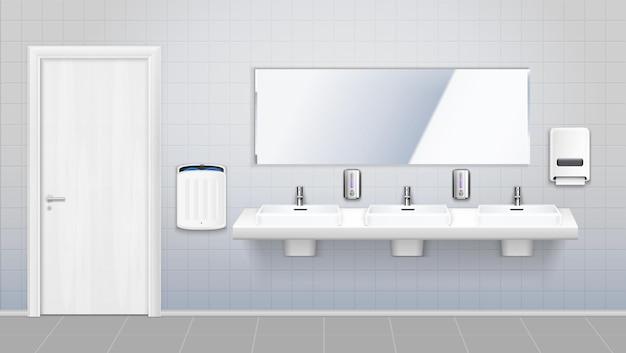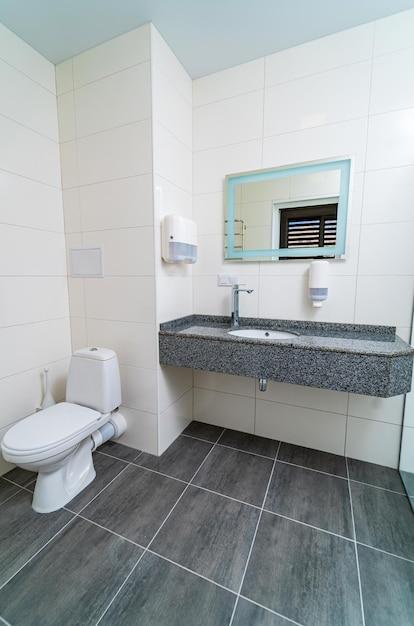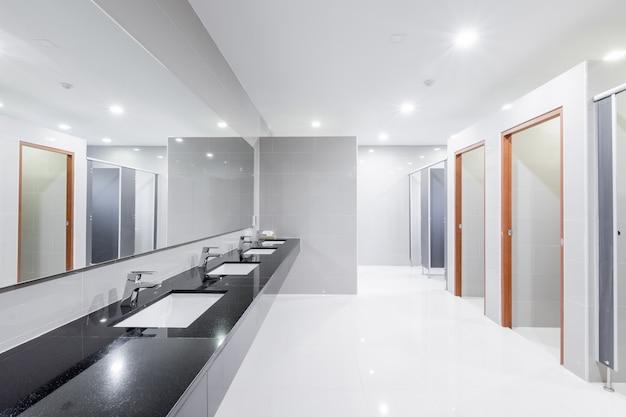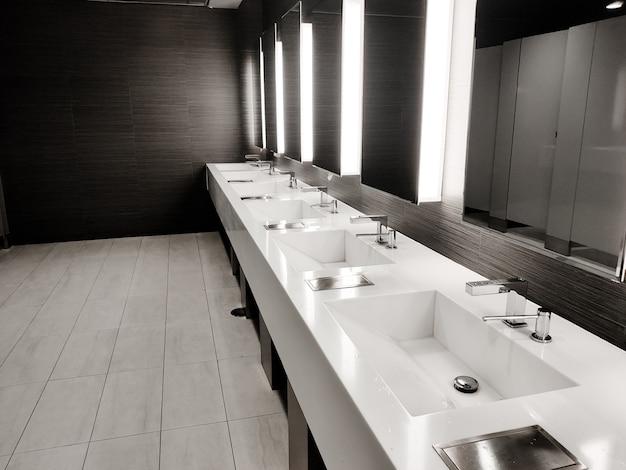As a business owner or manager, one of the key considerations when designing or renovating a commercial restroom is the choice of materials to use for the walls. Commercial bathroom walls and partitions have to meet particular design and safety requirements, and there are several materials options available for use.
But what type of wall finish is ideal for your commercial restroom? Do you need to tile the walls, or can you use other materials? Are there specific regulations or commercial bathroom wall finish requirements you have to keep in mind?
In this blog post, we’ll explore the different types of commercial restroom walls and partitions available. We’ll also look at the benefits and disadvantages of each material, explore the necessary commercial bathroom wall finish requirements, and answer common questions like, “What is the best paint finish for a public restroom?” and “How many bathrooms are required in a commercial building?”
By the end of this blog post, you’ll have all the information you need to make an informed decision on what material is right for your commercial bathroom walls. So, whether you are renovating an existing bathroom or designing a new one, join in on this informative discussion and learn more about the best options for commercial restroom walls and partitions.
The Importance of Commercial Restroom Walls
As a business owner, one area that you should focus on is the design of your restroom space, particularly your commercial restroom walls. Your walls set the tone for the entire restroom, and if they are subpar, it can have a negative impact on your overall business image.
Improved Aesthetics
Commercial restroom walls help to complete the overall look and design of your restroom space. If your walls are outdated, have cracks, or are difficult to clean, then your restroom space can look unkempt and uninviting. Upgrading your commercial restroom walls can vastly improve the aesthetics of your entire restroom space.
Enhanced Hygiene
Your commercial restroom walls should be easy to clean, disinfect, and maintain. This is particularly important in today’s world where hygiene is of utmost importance. By investing in high-quality commercial restroom walls, you can ensure that your restroom space is always clean, disinfected, and ready to use.
Increased Durability
Commercial restroom walls must be durable and withstand the wear and tear of daily usage. By opting for high-quality commercial restroom walls, you’ll be ensuring that your walls last longer and require minimal repair and maintenance.
Design Flexibility
The beauty of commercial restroom walls is that they come in a wide variety of designs, materials, and finishes. This means that you can have walls that complement other aspects of your restroom space. You can opt for tiled walls that are easy to clean and provide a luxurious look or paintable walls that offer design flexibility.
Improved Business Image
Last but not least, investing in high-quality commercial restroom walls can improve your overall business image. By having a clean, hygienic, and well-maintained restroom space, your customers will view your business in a positive light, leading to repeat visits and positive reviews.
In conclusion, commercial restroom walls are a crucial part of your overall restroom design. They can greatly impact the aesthetics, hygiene, durability, design flexibility, and business image. When investing in commercial restroom walls, opt for high-quality materials, designs, and finishes that align with your overall business objectives.
Commercial Bathroom Walls: How to Choose the Right Material
When it comes to commercial bathroom walls, there are many materials to choose from. Each option has its own set of strengths and weaknesses, making it important to select the right one for your specific needs.
1. Ceramic Tiles
Ceramic tiles are a popular choice for commercial bathroom walls because they are durable, easy to maintain, and come in various shapes and sizes. They are also water-resistant, making them ideal for high-moisture environments. However, ceramic tiles can be costly, and the grout lines between them can be challenging to clean.
2. Solid Surface Panels
Solid surface panels are made of acrylic or polyester resins, reinforced with minerals. They offer a seamless and hygienic solution for commercial bathroom walls because they are non-porous and easy to clean. Solid surface panels are also customizable and available in many colors. However, they are relatively expensive and can scratch or chip easily.
3. Stainless Steel
Stainless steel is a durable and attractive option for commercial bathroom walls. It is resistant to corrosion and can withstand harsh chemicals. Stainless steel is also easy to maintain and offers a modern and sleek appearance. However, it is one of the costlier options and can be prone to scratches and dents.
4. Phenolic Panels
Phenolic panels are composed of layers of resin-soaked paper that are bonded with heat and pressure. They are easy to install, maintain, and come in many colors. Phenolic panels are also water-resistant and can withstand high traffic areas. However, they can be affected by heat and may not be suitable for areas with severe temperature fluctuations.
5. Painted Drywall
Painted drywall can be a cost-effective solution for commercial bathroom walls. It is easy to install and offers a wide range of color options. However, painted drywall is prone to moisture damage and can be challenging to clean.
Choosing the right material for your commercial bathroom walls depends on various factors, including budget, durability, and aesthetics. Ceramic tiles and solid surface panels are excellent options for high-moisture environments, while stainless steel is ideal for a modern look. Phenolic panels are a durable and customizable solution, and painted drywall can be a budget-friendly alternative. By considering these options and weighing their pros and cons, you can select the best wall material for your needs and budget.
Commercial Restroom Partitions
When it comes to commercial restroom walls, partitions are also an essential aspect to consider. These partitions are designed to separate the toilets, urinals, and washbasins to ensure privacy and comfort for the people using the restrooms. In this section, we’ll explore everything you need to know about commercial restroom partitions.
Types of commercial restroom partitions
There are various types of commercial restroom partitions you can choose from. They include:
Floor-mounted overhead-braced partitions
These partitions are the most popular type in commercial restrooms. They are known for their stability and endurance and can withstand heavy use. They are installed by anchoring the partitions to the floor and overhead support.
Ceiling hung partitions
These partitions are suspended from the ceiling and don’t touch the floor or walls. They are considered an excellent choice for easy cleaning and maintenance.
Floor-to-ceiling partitions
As the name suggests, these types of partitions are attached to both the floor and the ceiling. They provide superior strength and stability and offer the most privacy.
Advantages of commercial restroom partitions
Installing commercial restroom partitions comes with several benefits. They include:
-
Privacy: partitions ensure users are comfortable and enjoy their private space while using the restroom.
-
Hygiene: partitions make it easier to maintain cleanliness and hygiene by preventing water or soap splatters from spreading all over the washroom.
-
Durability: partitions are made from quality materials and are designed to withstand heavy abuse and usage.
-
Customization: partitions come in different materials, sizes, colors, and designs to blend with your interior décor and branding.
Commercial restroom partitions are critical components in providing functional and safe amenities for customers and staff. Consider these factors when selecting the best partitions for your organization: durability, customization, privacy, hygiene, and types of partitions. Choose wisely, and you won’t regret it!
What Are Your Options for Commercial Restroom Walls
When it comes to commercial restroom walls, there are numerous options to choose from. Each material has its pros and cons, and the final decision mainly depends on various factors like cost, durability, maintenance, and aesthetics. In this section, we’ll take a closer look at some popular walling materials specifically designed for commercial restrooms.
1. Ceramic tiles
Ceramic tiles are a popular choice for commercial restroom walls due to their durability, style, and relatively low maintenance. These tiles are available in various colors, shapes, and sizes, allowing you to develop unique bathroom designs. Nevertheless, ceramic tiles can be challenging to install, and the grout lines between the tiles tend to darken over time, making them unappealing.
2. Glass
Glass has become quite popular in recent years, particularly in modern commercial restrooms designs. Glass walls provide a clean, bright, and airy look that can make a small bathroom feel more spacious. Additionally, glass is effortless to clean and maintain and does not stain or discolor like some other materials. However, glass can be costly, fragile, and might require regular cleaning to keep it looking pristine.
3. Stainless Steel
Stainless steel is a perfect option for commercial restrooms in high traffic areas, such as airports and malls. Stainless steel is incredibly durable, easily sanitized, and resistant to water, heat, and corrosion. Additionally, stainless steel has a modern and functional look that blends well with other materials like glass, wood, or concrete. However, stainless steel can be expensive and tends to show fingerprint smudges and scuffs.
4. Solid Surface
Solid surface materials such as Corian have become increasingly popular for use in commercial bathrooms due to their seamless and smooth surface. Solid surface wall panels are composed of polyester or acrylic resins and minerals, making them highly resistant to scratches, stains, and even burns. They are durable, hygienic, and available in a vast array of colors and textures, providing a wide variety of design options. Despite their benefits, solid surface walls tend to be expensive compared to other materials.
In conclusion, there’s no perfect wall material for commercial restroom walls. Each option has its strengths and weaknesses, and the best choice depends on your specific needs, space, and budget. However, by weighing the pros and cons of each material, you can make an informed decision and ultimately choose a durable, hygienic, and attractive option, making your restroom a comfortable experience for everyone.
Do Bathroom Walls Need to be Tiled
If you’re considering remodeling your commercial restroom, you might be wondering whether bathroom walls need to be tiled. Tiling the walls of your bathroom can be an easy way to make it look more polished and clean, but it’s not always necessary.
Advantages of Tiling Bathroom Walls
Tiling bathroom walls comes with many advantages. One major advantage of tiling bathroom walls is that it helps to protect the walls from water damage. Water can quickly damage paint or wallpaper, leading to peeling, warping, and other issues. Tiling the walls is a waterproof solution to keep your walls in good condition.
Another advantage of tiling bathroom walls is that it’s easy to clean. Bathroom walls are often exposed to moisture, grime, and dirt, whereas a tiled wall can be easily wiped clean with a wet cloth or sponge.
Moreover, the tiles come in a variety of colors, sizes, and textures, so you can choose the tiles that suit your style and preferences.
Walls That Don’t Need Tiling
If you’re on a budget, it may not be necessary to tile your bathroom walls. A simple alternative is to paint the walls. You can choose a paint that is moisture-resistant and easy to clean. Painted walls look great, and it’s a cost-effective way to freshen up your commercial restroom.
Another alternative to tiling bathroom walls is to install wall panels. Wall panels provide a waterproof barrier that protects your walls, and they are easy to install. Wall panels mimic the texture and appearance of tiles, and they provide a sleek and modern look.
In conclusion, bathroom walls don’t necessarily need to be tiled, but it’s a great option if you’re aiming for a polished, waterproof, and easy-to-clean finish. However, if you’re on a budget or looking for a quick and easy alternative to tiles, painting or installing wall panels can provide a similar effect. The choice you make ultimately depends on your preferences, budget, and design goals.
Commercial Bathroom Partitions Near Me
Are you looking to install commercial bathroom partitions near your location? Look no further! Commercial bathroom partitions are an essential component of any restroom, and it’s crucial to get the right fit for your business. In this section, we’ll explore some of the best places to find commercial bathroom partitions near you.
Home Improvement Stores
Home improvement stores such as Home Depot and Lowe’s are a great place to start your search for commercial bathroom partitions. They offer a wide variety of products at affordable prices, making them an excellent option for both small and large businesses.
Online Retailers
Online retailers such as Amazon and Wayfair provide an extensive selection of commercial bathroom partitions, making it easy to compare prices and find the perfect fit for your restroom. Moreover, they often offer free shipping, which can save you a lot of money.
Local Contractors
Local contractors in your area specialize in installing commercial bathroom partitions and can provide valuable insights into which partitions can meet your needs. They can also provide you with a more personalized experience and help you with the installation process.
Commercial Interior Designers
Working with a commercial interior designer that specializes in restroom design can be a great option for larger businesses. They can provide you with a custom-tailored solution for your restroom, including commercial bathroom partitions, that matches your brand image and style.
In conclusion, finding the right commercial bathroom partitions can be a daunting task, but with the above options, you can easily find the perfect solution that fits your budget and requirements. Whether you choose to procure from home improvement stores, opt for online retailers, work with local contractors, or a commercial interior designer, you can rest assured of a transforming your restroom into a stylish and functional space.
Commercial Bathroom Wall Finish Requirements
When it comes to commercial restroom walls, choosing the right wall finish is crucial. The wall finish you select has a significant impact on the overall durability, maintenance, and hygiene of your commercial bathroom’s walls. In this article, we will highlight the requirements you should consider to ensure you choose the right commercial bathroom wall finish.
Durability
Durability is a top requirement to consider when choosing a commercial bathroom wall finish. The walls of your commercial bathroom are subjected to daily use, which exposes them to scratches, dents, and impact. Therefore, you need to choose a wall finish that can withstand wear and tear, such as high-pressure laminates, porcelain tiles, or solid surfacing materials.
Hygiene
Hygiene is another critical requirement to consider when selecting a commercial bathroom wall finish. A well-sanitized bathroom wall prevents the spread of bacteria and other infectious microorganisms. Smooth, non-porous materials like ceramic tiles are easy to clean and maintain. Choose wall finishes that resist bacteria and stains while retaining their quality even after frequent cleaning.
Aesthetics
Aesthetics is a critical requirement to consider when choosing a commercial bathroom wall finish. A beautiful bathroom wall can improve the overall bathroom ambiance, creating a positive image for your business. There are different wall finishes to choose from, such as painted drywall, wall panels, and ceramic tiles. Select a wall finish that matches the bathroom’s style, decor, and brand image.
Cost
Cost is an essential factor to consider when selecting a commercial bathroom wall finish. The cost of materials and installation may vary depending on the type of wall finish. While it is tempting to opt for the cheapest option, don’t compromise on durability and hygiene requirements. Consider a wall finish that offers lasting value for money while maintaining your desired aesthetics.
In summary, choosing the right commercial bathroom wall finish is crucial to your business’s success. The wall finish should be durable, hygienic, aesthetically pleasing, and cost-effective. By following these requirements, you can select the right wall finish and enjoy long-lasting value.
What Material is Used in Commercial Bathroom Walls
Commercial restroom walls can be made using various materials, and each option comes with its benefits and drawbacks. The material used in commercial bathroom walls is essential in determining how easy it is to clean, how durable it is, and its aesthetic appeal. Here are the most common materials used for commercial restroom walls.
1. Fiberglass Reinforced Plastic (FRP)
Fiberglass reinforced plastic, more commonly known as FRP, is a popular material used in commercial restroom walls. It is durable, moisture and impact-resistant, and easy to clean. Furthermore, it is lightweight and flexible, making it easy to install around corners and curved walls. FRP is a popular choice for public restrooms, hospitals, and schools.
2. Solid Surface
Solid surface materials are a new trend in commercial restroom walls. These materials are non-porous, seamless, and come in an array of colors and designs. Solid surface materials are easy to clean, making them ideal for commercial and public spaces. Some popular brands of solid surface materials include Corian and Krion.
3. Ceramic Tiles
Ceramic tiles are a classic option for commercial restroom walls. They come in various colors and patterns, are easy to clean, and can withstand high humidity levels. Ceramic tiles are a common choice for commercial restrooms in restaurants, hotels, and spas.
4. Stainless Steel
Stainless steel is a durable material that is moisture-resistant and easy to clean. It is ideal for high-traffic areas such as airports and sports facilities. Stainless steel walls give restrooms a modern and sleek appearance.
5. Painted Drywall
Painted drywall is a cost-effective, versatile, and customizable option for commercial restroom walls. However, it is porous, making it prone to damage caused by moisture and humidity. Painted drywall is an excellent choice for low-traffic restrooms, such as those in offices and small businesses.
In conclusion, the material used in commercial bathroom walls is an essential consideration when designing a restroom. Choosing the right material can make a significant difference in the durability, maintenance, and appearance of the restroom. When selecting a material, consider its durability, cost, design, and maintenance requirements, among other factors.
Best Paint Finish for a Commercial Restroom
When it comes to painting your commercial restroom walls, you need to think carefully about the paint finish you select. This will not only impact how your restroom looks but also how easily it stays clean.
Gloss or Semi-Gloss Finish
The first option to consider is a gloss or semi-gloss finish. This type of finish is very durable and easy to clean, which makes it perfect for commercial restrooms that experience heavy traffic.
One downside, however, is that it will highlight any imperfections on your walls. So, if your restroom walls are not perfectly smooth, the gloss or semi-gloss finish may not be the best option for you.
Eggshell or Satin Finish
Another option to consider is an eggshell or satin finish. This type of finish is less shiny than gloss or semi-gloss but still has a slight sheen. It is durable and easy to clean, making it a good option for commercial restrooms.
An eggshell or satin finish is also good at hiding small imperfections on your walls. So, if your restroom walls are not perfectly smooth, this finish might be a better choice.
Flat or Matte Finish
Finally, you can choose a flat or matte finish for your commercial restroom walls. This type of finish is not shiny at all, which means it won’t highlight any imperfections on your walls.
However, it is not as durable as gloss, semi-gloss, or eggshell finishes, and it is more challenging to clean. So, if you opt for a flat or matte finish, you need to make sure you have a maintenance plan in place to keep your walls clean.
When selecting the best paint finish for your commercial restroom walls, you need to take into account your traffic levels, desired level of shine, and the condition of your walls. Consider the pros and cons of each finish, and don’t be afraid to ask a professional for advice. With the right finish, your commercial restroom will look great and be easy to maintain.
How Many Bathrooms are Required in a Commercial Building
When designing and building a commercial building, it’s important to ensure that the restroom facilities meet the needs of the occupants. One of the questions that frequently arises during the design process is how many restrooms are required. In this section, we’ll discuss the factors that determine the number of bathrooms needed in a commercial building.
Occupancy and Building Codes
The number of bathrooms required in a commercial building depends on the occupancy and the number of occupants. The International Building Code (IBC) specifies the minimum requirement for the number of restrooms based on the occupancy. For example, in an office building with up to 15 occupants, one toilet and one sink are required for each gender. If the building has 76 or more occupants, the requirement increases to two toilets and two sinks for each gender. Other types of buildings, such as schools, hospitals, and restaurants, have their own specific requirements.
Peak Demand
Designers and builders should also take into consideration peak demand. This refers to the time of day when the restroom facilities are most likely to be used. For example, if the building has a lunchroom, the restrooms will likely experience a peak in usage during the lunch hour. The restrooms should be designed to accommodate this peak demand to ensure that there are no long wait times or lines forming.
Amenities and Accessibility
The layout, accessibility, and amenities of the restrooms also play a role in determining the number of bathrooms required. For example, if the restroom facilities are located on multiple levels, each level may require its own set of restrooms. Additionally, if the building has amenities such as a gym or pool, additional restrooms may be required to accommodate the added demand.
In conclusion, the number of bathrooms required in a commercial building depends on various factors such as occupancy, peak demand, amenities, and accessibility. Building codes set the minimum requirements for the number of restrooms, but designers and builders should also consider the specific needs of the occupants and the building’s intended use. Proper planning and design of the restrooms will ensure that the occupants of the building have access to the necessary facilities without any inconvenience or discomfort.



